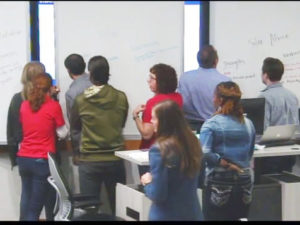Posted on November 15, 2018 by Joanna Carver
 "I want students in my class to have a paradigm shift,” said Keeton. “When we introduce this topic there is resistance. The resistance is expected and is normal–I am challenging the class to figure out how they can work around it.”
"I want students in my class to have a paradigm shift,” said Keeton. “When we introduce this topic there is resistance. The resistance is expected and is normal–I am challenging the class to figure out how they can work around it.”
The term crowdsourcing, which describes the process of using the power of the crowd to solve problems or complete tasks, is trendy but not new. A blog post by Alec Lynch in 2010 on the history of crowdsourcing shares an example from 1714, where the British Government offered a monetary prize for a solution to “The Longitude Problem,” which killed thousands of sailors every year.
The goal of the class is that EMBA students will walk away with an understanding of how crowdsourcing can be used as a resource to achieve innovative solutions or access specific expertise.
In a 2016 report by Deloitte, they estimated that 75 percent of high-performing enterprises globally would use some form of crowdsourcing by 2018.
Keeton, who worked as a contractor for NASA, shared that her team was able to develop a viable path that allowed NASA employees to harness crowdsourcing to accelerate and build capacity for software design, product development and other innovations.
“There are so many examples of how organizations large and small have embraced crowdsourcing,” said Keeton. “For example, companies like Frito Lay, General Electric and General Mills have entire departments that only use crowdsourcing platforms to solve problems.”
Keeton’s EMBA class had the opportunity to participate in a real crowd-based experience evaluating borrowers’ proposals for the international nonprofit crowdfunding platform, Kiva. Kiva’s new platform crowdvet.org relies on crowdsourcing rather than crowdfunding to provide graduate business students and working professionals with unique insight into social investing.
Participants on crowdvet.org gain firsthand experience in social investing and real social enterprise business models, as they review, discuss and evaluate proposals from social enterprises and prioritize projects. In return, Kiva is able to review proposals faster and reduce barriers for social enterprises to access capital.
“In this version of crowdvet.org, the crowd’s votes are monitored by Kiva staff, and they serve as an additional data point in helping make the final decision. Votes, comments and questions from the crowd help streamline the process. Eventually, we hope to have a platform where the crowd can make decisions without Kiva’s supervision,” says Carlos Pierre, Kiva’s director of investments.
Keeton hopes that through experiences such as these, UTSA EMBA students will not only gain a better understanding of crowdsourcing but will also discover the benefits of employing it in their own organizations.

